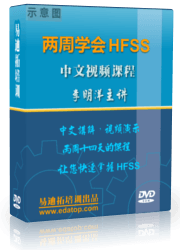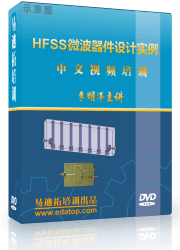- 易迪拓培训,专注于微波、射频、天线设计工程师的培养
HFSS finite conductivity 问题
不行,PEC是无损耗的,finite conductivity 是有损的. 边界条件处理时候是不一样的
我认为是这样哈
个人观点:由于常用金属的电导率非常高,在微波频率下趋肤深度极小。因此可按PEC边界分析场,然后进行修正。对于金属热损耗可忽略的问题,PEC边界和finite conductivity 得到的值应没有明显差别,但是对于高Q值的金属谐振腔,finite conductivity 的参数就至关重要了。至于glass和finite conductivity 风马牛不相及。
同意前面的,通常设置金属导体或是PEC对结果影响不大,起码我在算微带、带线时没发现什么不同
多谢解答
还有点点疑问,如果材料已定,比如为铜等金属导体,他的电导率肯定是已定了,那设置finite conductivity 还有什么意义呢?是不是finite conductivity的设置情景跟perfect E之类是一样的?
关于这个问题HFSS帮助上的部分段落现COPY于下:
(1)、Solving Inside or on the Surface
When you assign a material to an object, you can specify whether to generate a field solution inside the object or on the surface of the object. If you elect to generate a solution inside the object, HFSS will create a mesh inside the object and generate a solution from the mesh. If you elect to generate a solution on the surface of the object, HFSS will create only a surface mesh for the object.
If you want a solution to be generated inside an object, select Solve Inside in the Properties window. Conversely, if you want a solution to only be generated on the surface of an object, clear the Solve Inside option in the Properties window.
By default, Solve Inside is selected for all objects with a bulk conductivity less than 105 siemens/meter and for perfect insulators. By default, the Solve Inside option in the Properties window is clear for perfect conductors.
To change the threshold for solving inside objects, do the following:
1. Under the Tools menu, point to Options, and then click HFSS Options.
2. Under the General tab, enter a new value in the Solve Inside threshold text box.
Finite Conductivity Boundaries
(2)In HFSS, finite conductivity boundaries represent imperfect conductors.
The surfaces of any objects defined to be non-perfect conductors are automatically set to finite conductivity boundaries. Note that HFSS does not attempt to compute the field inside these objects; the finite conductivity boundary approximates the behavior of the field at the surfaces of the objects.
The finite conductivity boundary condition is valid only if the conductor being modeled is a good conductor, that is, if the conductor’s thickness is much larger than the skin depth in the given frequency range. If the conductor's thickness is in the range or larger than the skin depth in the given frequency range, HFSS’s layered impedance boundary condition must be used.
同时在设置finite conductivity boundaries的对话框上有选择材料的选项,因此个人认为设置金属和设置finite conductivity boundaries是等效的
多少有点明白,个人以为finite conductivity 的设置和材料的设置不矛盾,当非理想导体材料达到一定厚度时需要设置的,不知道这种理解正不正确。多谢前面热心解答!
HFSS对体电导率小于10的5次方siemens/meter 的材料和理想绝缘体材料,物体内部是划分网格计算场的。否则默认只对表面划分网格,计算场。
从物理上讲,当导体电导率非常高,趋肤深度极小,场只存在于导体表面极薄的一层。举个例子,对于铜,电导率5×10的7次方S/m,当频率100MHz时,趋肤深度只有7微米。若软件计算导体内部场,可以想象需要多大数量的网格呀。同时由于趋肤深度极小,忽略它的尺寸并不会对结构尺寸产生影响,例如趋肤深度的尺寸vs空波导管的尺寸。
因此一般情况下在HFSS设置有限电导率和设置导电金属材料是一样的。
至于趋肤深度的影响不可忽略时,需要另行考虑了。自己感觉做软件更多的是做物理。
这个讨论不错,标记一下
申明:网友回复良莠不齐,仅供参考。如需专业解答,请学习易迪拓培训专家讲授的HFSS视频培训教程。







